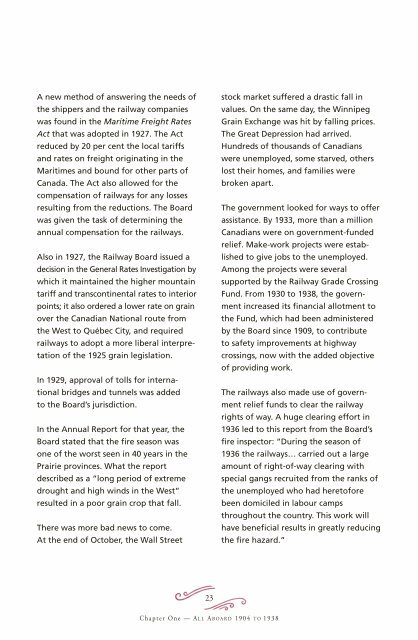time the Canadian economy entered adownturn that lasted into the mid-1920s.The railways re<strong>du</strong>ced some rates of theirown accord and the railway commissionlowered some more.In 1922, the government appointed aspecial committee to study the CrowsnestPass Agreement of 1897, in which theCPR had agreed to certain rate re<strong>du</strong>ctions.The committee restored some partsof the original Crow agreement—whichhad been lifted <strong>du</strong>ring the war—tore<strong>du</strong>ce rates for shippers. 15In 1923 the Board, at the request ofcabinet, re<strong>du</strong>ced railway rates on grainexports from Vancouver.In October, after a seven-day hearing, theBoard decided to help the railways bydispensing with the Crowsnest PassAgreement, <strong>des</strong>pite the 1922 statute thathad reinstated the relatively low Crowrate on grain.An appeal to the Supreme Court by theWestern provinces resulted in a ruling in1925 that the Board couldn’t drop theCrow rate. The railways could, however,use the narrow interpretation of theagreement as set in 1897. In response,King’s government stepped in to cancelthe Crow-based rates, except those ongrain and flour. Parliament also orderedthe Board to hold a general inquiry intoother rate issues. 16On August 9, 1924, Frank Carvell diedamid a clamour for an investigation ofthe Crow rate.Prime Minister Mackenzie Kingappointed Harrison A. McKeown, thechief justice of New Brunswick’s SupremeCourt, to replace Carvell. McKeown hadserved in the New Brunswick legislatureas Solicitor General and AttorneyGeneral. In 1908, he was appointed ajustice of the province’s Supreme Courtand later Chief Justice. He had alsotaught law, and had been dean of thelaw faculty at the University of NewBrunswick from 1922 to 1924. McKeownwas 61 when he joined the Board and hesoon found problems of his own.On September 2, McKeown andCommissioner Frank Oliver, a Westernerwho had founded the EdmontonBulletin, approved fixing the grain ratesto Vancouver based on the Crow rate.They did this <strong>des</strong>pite the opposition ofthree other Board members, who hadmade a decision on the same issue in1923. Simon J. McLean, who had beenwith the Board for 17 years, A.C. Boyceand Calvin Lawrence, were concerned,in fact, by the lack of impartiality inMcKeown’s decision. McLean summe<strong>du</strong>p their objection “that fairness andreasonableness of the rate is to bedetermined on the facts after <strong>du</strong>eenquiry; that the order was issued on arecord partially heard and incomplete”. 1722Canadian Transportation Agency — 100 Years at the Heart of Transportation
A new method of answering the needs ofthe shippers and the railway companieswas found in the Maritime Freight RatesAct that was adopted in 1927. The Actre<strong>du</strong>ced by 20 per cent the local tariffsand rates on freight originating in theMaritimes and bound for other parts of<strong>Canada</strong>. The Act also allowed for thecompensation of railways for any lossesresulting from the re<strong>du</strong>ctions. The Boardwas given the task of determining theannual compensation for the railways.Also in 1927, the Railway Board issued adecision in the General Rates Investigation bywhich it maintained the higher mountaintariff and transcontinental rates to interiorpoints; it also ordered a lower rate on grainover the Canadian National route fromthe West to Québec City, and requiredrailways to adopt a more liberal interpretationof the 1925 grain legislation.In 1929, approval of tolls for internationalbridges and tunnels was addedto the Board’s jurisdiction.In the Annual Report for that year, theBoard stated that the fire season wasone of the worst seen in 40 years in thePrairie provinces. What the report<strong>des</strong>cribed as a “long period of extremedrought and high winds in the West”resulted in a poor grain crop that fall.There was more bad news to come.At the end of October, the Wall Streetstock market suffered a drastic fall invalues. On the same day, the WinnipegGrain Exchange was hit by falling prices.The Great Depression had arrived.Hundreds of thousands of Canadianswere unemployed, some starved, otherslost their homes, and families werebroken apart.The government looked for ways to offerassistance. By 1933, more than a millionCanadians were on government-fundedrelief. Make-work projects were establishedto give jobs to the unemployed.Among the projects were severalsupported by the Railway Grade CrossingFund. From 1930 to 1938, the governmentincreased its financial allotment tothe Fund, which had been administeredby the Board since 1909, to contributeto safety improvements at highwaycrossings, now with the added objectiveof providing work.The railways also made use of governmentrelief funds to clear the railwayrights of way. A huge clearing effort in1936 led to this report from the Board’sfire inspector: “During the season of1936 the railways… carried out a largeamount of right-of-way clearing withspecial gangs recruited from the ranks ofthe unemployed who had heretoforebeen domiciled in labour campsthroughout the country. This work willhave beneficial results in greatly re<strong>du</strong>cingthe fire hazard.”23Chapter One — ALL A BOARD 1904 TO 1938
- Page 1 and 2: A Centennial Historical Perspective
- Page 3: AcknowledgmentsAcentury ago, on Feb
- Page 7 and 8: Chairman’s MessageIn 2004, the Ca
- Page 9: Dealing with Persons with Disabilit
- Page 12 and 13: The Board of Railway Commissioners1
- Page 14 and 15: water transportation and with Ameri
- Page 16 and 17: Laurier would not be deflected from
- Page 18 and 19: declared. Among Laurier’s promise
- Page 20 and 21: that illustrate the early acceptanc
- Page 26 and 27: ailway with other railways that the
- Page 30 and 31: The next year, the fire inspector r
- Page 32 and 33: Then he set about reforming Canada
- Page 35 and 36: CHAPTER TWOEngines of ChangeThe Boa
- Page 37 and 38: Howe was 49 years old in 1935 whenh
- Page 39 and 40: As the Board reiterated in later wa
- Page 41 and 42: Mackenzie King had made an earlierA
- Page 43 and 44: Wage and price controls were droppe
- Page 45 and 46: this extended period (of freight ra
- Page 47 and 48: development. The Board’s AnnualRe
- Page 49 and 50: moved into the Chief Commissioner
- Page 51 and 52: platform). The Board’s policy app
- Page 53 and 54: Prize. On November 8, 1965, the thi
- Page 55: Notes for Chapter TwoThe Board of T
- Page 58 and 59: The Canadian Transport Commission19
- Page 60 and 61: 1967. In late 1968, the CTC set up
- Page 62 and 63: for the different modal committees.
- Page 64 and 65: The railways had also started to in
- Page 66 and 67: The CTC’s policy in this regard i
- Page 68 and 69: CSTM/CN000559things, I want to be a
- Page 70 and 71: government was willing to provide u
- Page 72 and 73: “The reforms that can already be
- Page 74 and 75: Minister Axworthy introduced a newC
- Page 76 and 77: create an agency to replace the Can
- Page 79 and 80:
CHAPTER FOURShifting GearsThe Natio
- Page 81 and 82:
for a maximum of nine full-time Mem
- Page 83 and 84:
compensatory to cover the actual co
- Page 85 and 86:
the newspaper report, CNR and CPRwe
- Page 87 and 88:
more quickly. The committee alsorec
- Page 89 and 90:
Review also noted an increase inint
- Page 91:
Notes for Chapter FourThis chapter
- Page 94 and 95:
The Canadian Transportation Agency1
- Page 96 and 97:
to make transportation accessible t
- Page 98 and 99:
would be responsible for investigat
- Page 100 and 101:
The Commissioner was required to ma
- Page 102 and 103:
In another obesity case, also invol
- Page 104 and 105:
Washington and a field in ruralPenn
- Page 106 and 107:
AppendixMembers’ ListBOARD OF RAI
- Page 108 and 109:
CANADIAN MARITIME COMMISSIONNAME PO
- Page 110 and 111:
B. Keith Penner Member January 1, 1
- Page 112:
Books and ArticlesBercuson, David J





